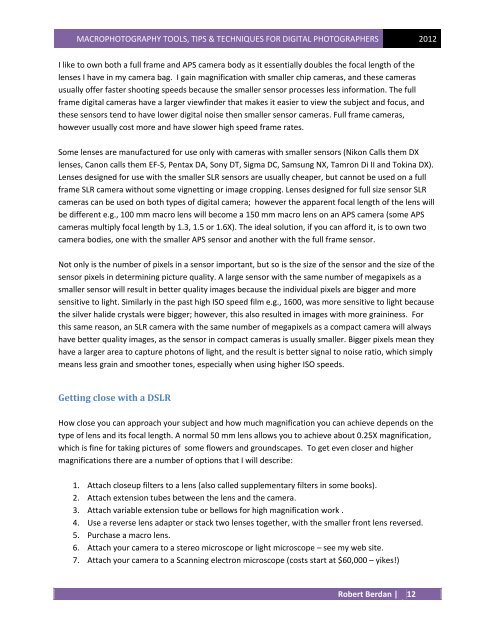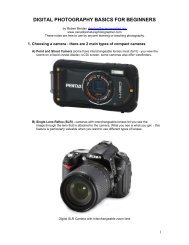Download PDF - The Canadian Nature Photographer
Download PDF - The Canadian Nature Photographer
Download PDF - The Canadian Nature Photographer
You also want an ePaper? Increase the reach of your titles
YUMPU automatically turns print PDFs into web optimized ePapers that Google loves.
MACROPHOTOGRAPHY TOOLS, TIPS & TECHNIQUES FOR DIGITAL PHOTOGRAPHERS 2012<br />
I like to own both a full frame and APS camera body as it essentially doubles the focal length of the<br />
lenses I have in my camera bag. I gain magnification with smaller chip cameras, and these cameras<br />
usually offer faster shooting speeds because the smaller sensor processes less information. <strong>The</strong> full<br />
frame digital cameras have a larger viewfinder that makes it easier to view the subject and focus, and<br />
these sensors tend to have lower digital noise then smaller sensor cameras. Full frame cameras,<br />
however usually cost more and have slower high speed frame rates.<br />
Some lenses are manufactured for use only with cameras with smaller sensors (Nikon Calls them DX<br />
lenses, Canon calls them EF-S, Pentax DA, Sony DT, Sigma DC, Samsung NX, Tamron Di II and Tokina DX).<br />
Lenses designed for use with the smaller SLR sensors are usually cheaper, but cannot be used on a full<br />
frame SLR camera without some vignetting or image cropping. Lenses designed for full size sensor SLR<br />
cameras can be used on both types of digital camera; however the apparent focal length of the lens will<br />
be different e.g., 100 mm macro lens will become a 150 mm macro lens on an APS camera (some APS<br />
cameras multiply focal length by 1.3, 1.5 or 1.6X). <strong>The</strong> ideal solution, if you can afford it, is to own two<br />
camera bodies, one with the smaller APS sensor and another with the full frame sensor.<br />
Not only is the number of pixels in a sensor important, but so is the size of the sensor and the size of the<br />
sensor pixels in determining picture quality. A large sensor with the same number of megapixels as a<br />
smaller sensor will result in better quality images because the individual pixels are bigger and more<br />
sensitive to light. Similarly in the past high ISO speed film e.g., 1600, was more sensitive to light because<br />
the silver halide crystals were bigger; however, this also resulted in images with more graininess. For<br />
this same reason, an SLR camera with the same number of megapixels as a compact camera will always<br />
have better quality images, as the sensor in compact cameras is usually smaller. Bigger pixels mean they<br />
have a larger area to capture photons of light, and the result is better signal to noise ratio, which simply<br />
means less grain and smoother tones, especially when using higher ISO speeds.<br />
Getting close with a DSLR<br />
How close you can approach your subject and how much magnification you can achieve depends on the<br />
type of lens and its focal length. A normal 50 mm lens allows you to achieve about 0.25X magnification,<br />
which is fine for taking pictures of some flowers and groundscapes. To get even closer and higher<br />
magnifications there are a number of options that I will describe:<br />
1. Attach closeup filters to a lens (also called supplementary filters in some books).<br />
2. Attach extension tubes between the lens and the camera.<br />
3. Attach variable extension tube or bellows for high magnification work .<br />
4. Use a reverse lens adapter or stack two lenses together, with the smaller front lens reversed.<br />
5. Purchase a macro lens.<br />
6. Attach your camera to a stereo microscope or light microscope – see my web site.<br />
7. Attach your camera to a Scanning electron microscope (costs start at $60,000 – yikes!)<br />
Robert Berdan | 12




